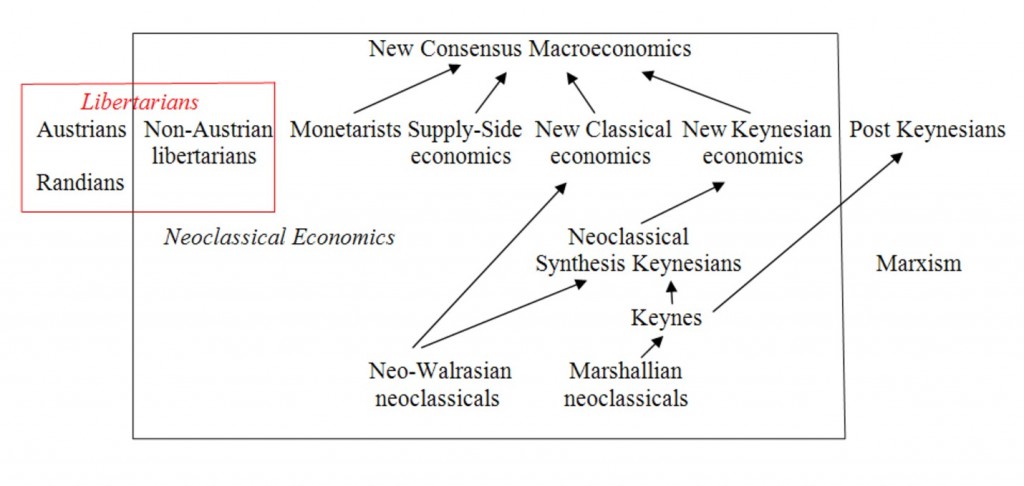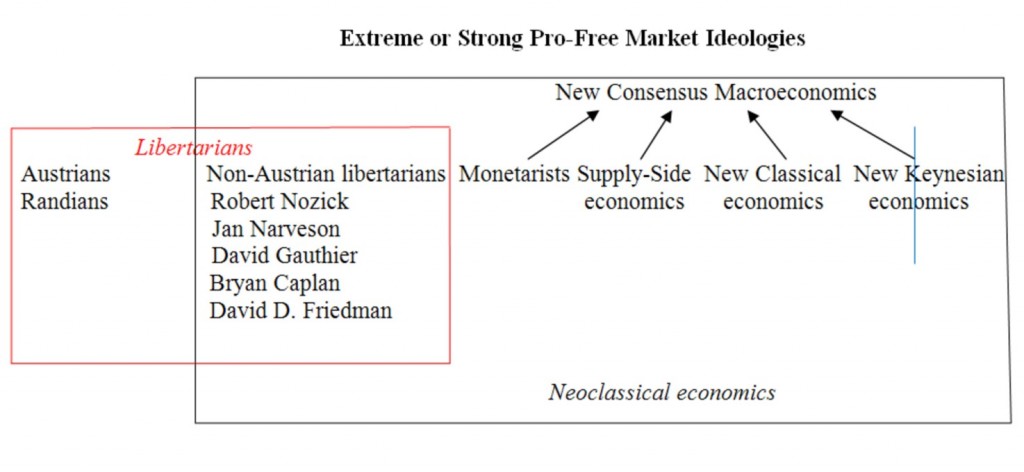In this page we describe the major schools of economics. The most part is posted thanks to Lord Keynes* of the blog Social Democracy for the 21st century, A post-Keynesian approach as appeared here. I edited the text to make things clearer and I removed the original bias towards Post Keynesianism.
Mainstream (New Consensus/Neo-classical) vs. Heterodox Schools
The major schools of economics can be divided into
- neoclassical theories and
- non-neoclassical or heterodox schools.
The neoclassical schools include Supply-side economics, Monetarism, New Classical economics, and New Keynesian economics.
The mainstream and orthodox approach to economics is the New Consensus Macroeconomics, which is a synthesis of the main neoclassical approaches. But the mainstream neoclassicals do not agree on all issues: at the higher level they can be found in different groups like the monetarists, New Classicals, and New Keynesians.
There are three major heterodox, or non-neoclassical traditions: Austrian economics, Post Keynesian economics, and Marxism (and Marxism has more in common with Classical economics/Classical political economy, an older economic theory).
These divisions can be seen in the chart below (please open it in a new tab or window to see a larger version).

Major economic schools (source) - Click to enlarge
On the development of the Keynesian schools, follow here “Neoclassical Synthesis Keynesianism, New Keynesianism and Post Keynesianism: A Review,” July 7, 2010.
Libertarian Theories
The various types of libertarians are discussed in “The Types of Pro-Free Market Libertarians,” January 30, 2011.
Compared to the Austrians, the monetarists and New Classicals in fact support numerous state interventions, and their economics is derived from a revived neo-Walrasian general equilibrium theory. In fact, many Austrians are hostile to the mainstream monetarists and New Classicals, and there are very significant differences between their economic ideas.
As we can see, not all economists who support extreme or strong free markets are libertarians. I have not included monetarists as libertarians, but of course there is some overlap between the two sets. Although it is true that some supply-siders, monetarists, New Classicals, and Republicans think of themselves as “libertarians” in some way as well, many in fact do not. Modern conservatism or conservative economics comes in many forms, and by no means can it all be simply labelled as “libertarianism”.
Perhaps a better division of extreme or strong pro-free market ideologues would be as follows:
- Libertarians, including Austrians (Anarcho-capitalists, Misesians, Hayekians, moderate subjectivists, radical subjectivists) and non-Austrian libertarians (Randians, Robert Nozick’s libertarianism, David D. Friedman’s anarcho-capitalism, and non-Austrian neoclassical libertarians), and
- Mainstream neoclassical theorists, including Supply-siders, Monetarists, New Classicals, and conservative New Keynesians.
This can be shown in another chart below:
Neoclassical Synthesis, Post Keynesians and New Keynesians
After 1945, there were two Keynesian traditions:
- the neoclassical synthesis and
- the Cambridge Keynesians, who were the founders and progenitors of the Post Keynesian school.
The neoclassical synthesis, developed by Hicks and Samuelsen bases on the IS-LM model, the Phillips curve, and on supply and demand models.
Post Keynesian economics has no need for, and rejects, the IS-LM model, the Phillips curve, and the empirically unsupported notion of the liquidity trap (Davidson 2002: 95). It is a more radical development of Keynesian theory, true to Keynes’ fundamental ideas (if not to all his more conservatively-minded policy recommendations), and has always rejected the foundational neoclassical axioms (namely, the gross substitution axiom, neutrality of money axiom, and the ergodic axiom).
The New Keynesians emerged after the collapse of neoclassical synthesis in the 1970s, but even modern New Keynesianism can be divided into conservative and liberal/progressive wings. Both Paul Krugman and Joseph Stiglitz are outstanding liberal New Keynesians. Despite the name “Keynesian”, there is a good deal of neoclassical theory in New Keynesian economics.
New Classical, Neoliberalism, Supply-side economics
The revival of neo-Walrasian neoclassical theory was done mainly by (1) Milton Friedman and (2) the New Classicals at the University of Chicago in the 1970s, including John F. Muth, Robert Lucas, Thomas J. Sargent, Robert J. Barro, Neil Wallace, Robert M. Townsend, Robert E. Hall, Edward C. Prescott and Finn E. Kydland. They have been one of the most powerful schools, with considerable influence.
The new neoclassical orthodoxy that emerged in the 1980s can be called “neoliberalism,” the “Washington consensus,” or “globalization”. George W. Bush took advice from the rather more neoliberal or economically conservative Republican New Keynesian N. Gregory Mankiw, who was chairman of Bush’s Council of Economic Advisors from 2003 to 2005.
Reaganomics and Thatcherism were blends of the various new neoclassical ideas. In particular, Reaganomics was a blend of monetarism and supply-side economics, with a type of military Keynesianism brought in via Reagan’s huge budget deficits. Thatcherism was a more doctrinaire neoliberal ideology influenced by Milton Friedman, with a tinge of Austrian rhetoric, via Friedrich von Hayek.
New Consensus Macroeconomics and the Financial Crisis
While forms of monetarism and supply-side economics rather quickly fell from favour amongst policy-makers, the New Classical economics emerged as the dominant neoclassical theory, and, through its arguments with the New Keynesians, the resulting synthesis lead to the New Consensus Macroeconomics by the early 1990s. It is this modern consensus that has come under severe attack in the wake of the 2007–2009 global financial crisis and great recession.
Inside our pages we discuss three big arguments against the New Consensus.
- Hyman P. Minsky’s “Financial Instability Hypothesis” and Charles Kindleberger description of the Great Depression (both see here). There are not yet economic schools based on these theories, even if economic journals titled “We are all Minskyites now”.
- Ricard Koo’s “Theory of Balance Sheet Recession”, a theory for the economic phase of debt deleveraging.
- Libertarian and Austrian economists with the Austrian “Boom and Bust Business Cycle”.






















2 comments
Nate
2015-06-09 at 02:18 (UTC 2) Link to this comment
Typical… you messed this up by not including georgism, although I admit it would be difficult to place.
Aditya
2020-12-13 at 22:17 (UTC 2) Link to this comment
Nate: To be honest, georgism is like feminist economics: Nobody cares!